I’ve always been fascinated by the diversity and behavior of birds. In this realm, few species captivate me as much as the Drongo.
Drongos are a group of passerine birds hailing from the Old World tropics, particularly in Africa, South Asia, and Australasia.
With their glossy black feathers and distinctive forked tails, they’re not just a sight to behold but possess some intriguing behavioral traits that set them apart.
One of their most noteworthy characteristics is their knack for mimicry. Mimicry isn’t uncommon among birds; however, with Drongos, it’s more than just an imitation game. These clever creatures use it as a survival strategy!
They’ve developed the ability to imitate other bird species’ alarm calls to scare off competition and snatch away food, displaying impressive cunning rarely seen in avian populations.
Moreover, what fascinates me about Drongos isn’t just their intelligence or beauty – it’s how these attributes come together in ways that challenge our understanding of animal behavior.
Their complex social structures and communication methods offer invaluable insights into evolutionary biology – making them compelling subjects for further research.
Different Species of Drongos
Drongos, with their charismatic personalities and distinct forked tails, are a fascinating group of birds that exhibit remarkable diversity across different regions of the world.
Here’s a closer look at some notable species:
Square-tailed Drongo (Dicrurus ludwigii)
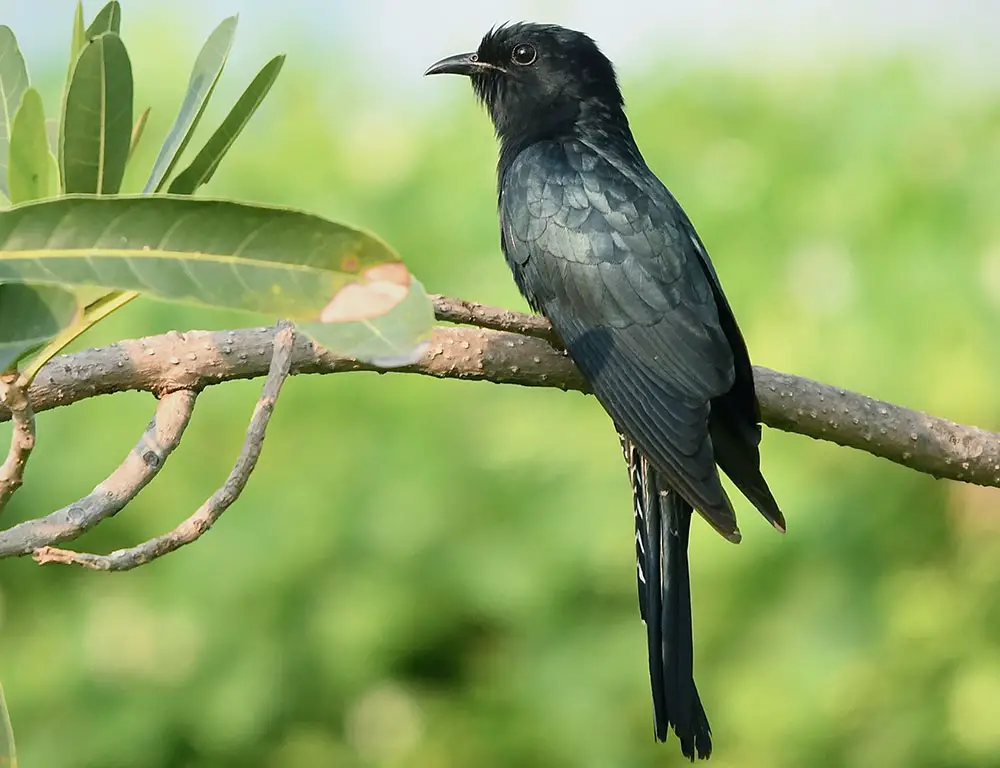
- Tail Shape: Square cut
- Color: All-black
- Geographic Location: Africa
- Description: The Square-tailed Drongo stands out with its sleek, all-black appearance and its unique square-cut tail. This adaptable bird is found across various African habitats, from dense forests to open savannas.
Spangled Drongo (Dicrurus bracteatus)
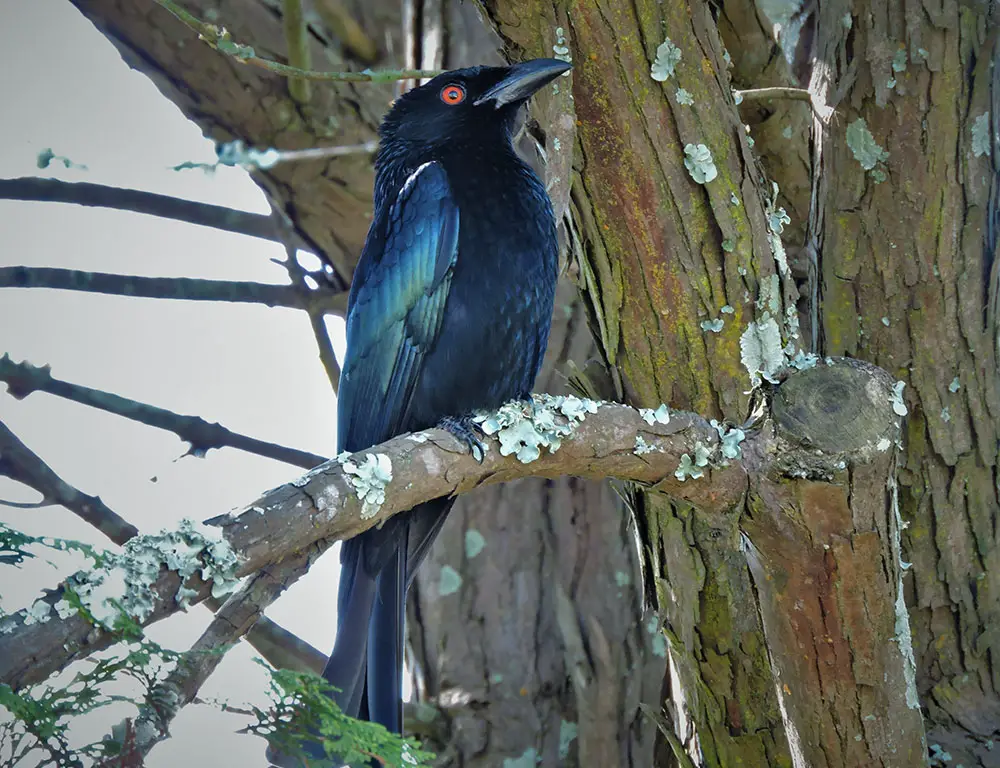
- Tail Shape: Fish-like
- Color: Shimmering metallic green-blue
- Geographic Location: Australia
- Description: Endemic to Australia, the Spangled Drongo is known for its iridescent plumage and distinctive fish-like tail shape. Its striking appearance and agile aerial acrobatics make it a sought-after sight for birdwatchers in the region.
Bronzed Drongo (Dicrurus aeneus)
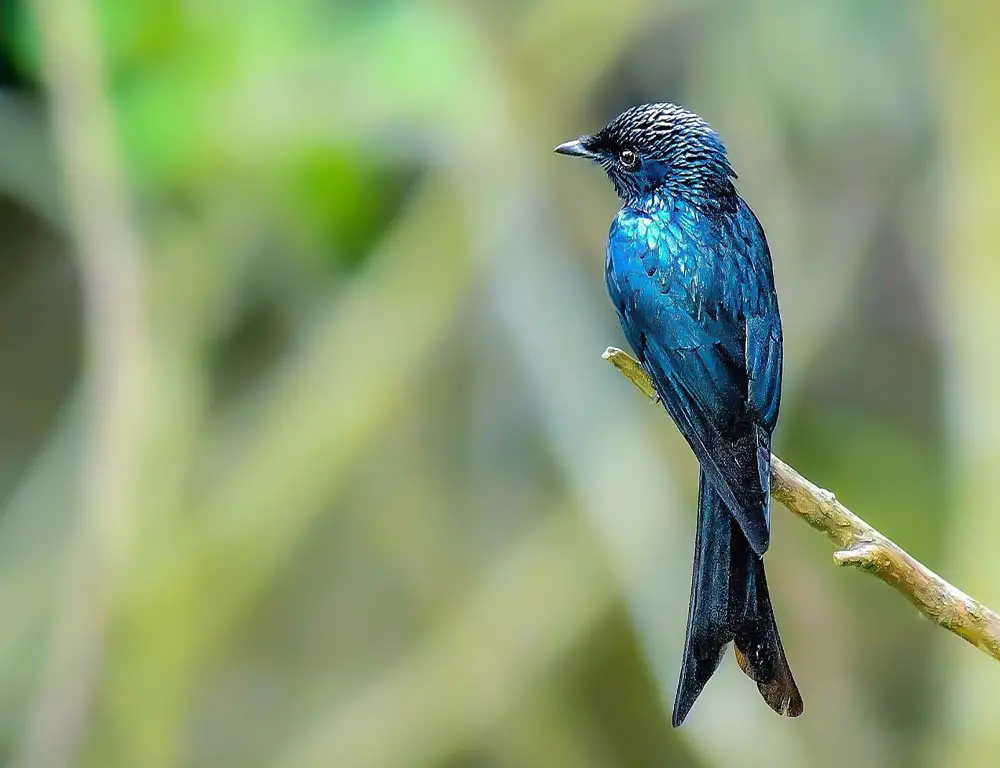
- Tail Shape: Normal forked
- Color: Bronze
- Geographic Location: Asia
- Description: With its bronze-colored feathers that glint in the sunlight, the Bronzed Drongo is a captivating species found in various parts of Asia. Its normal forked tail and agile flight make it an adept predator, often seen catching insects on the wing.
Crested Drongo (Dicrurus forficatus)
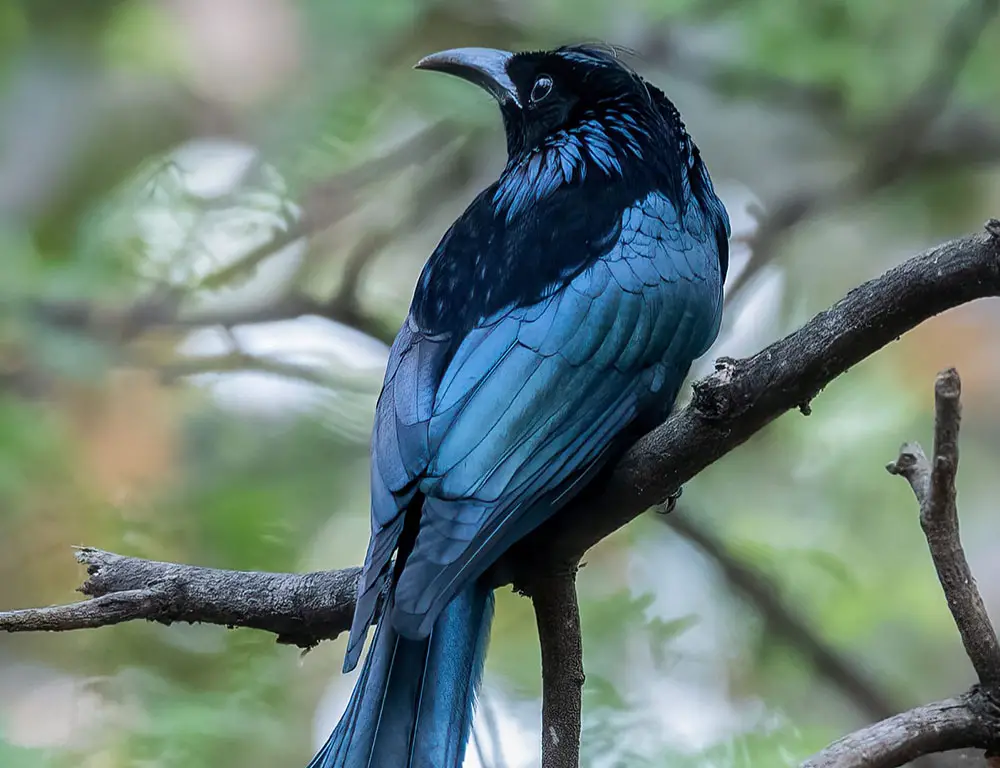
- Tail Shape: Normal forked
- Color: Black with slight green sheen
- Geographic Location: Madagascar
- Description: Endemic to Madagascar, the Crested Drongo is distinguished by its elaborate crest feathers atop its head. Despite its predominantly black plumage, it exhibits a subtle green sheen, adding to its allure in the lush forests of Madagascar.
Habitat and Behavior of Drongos
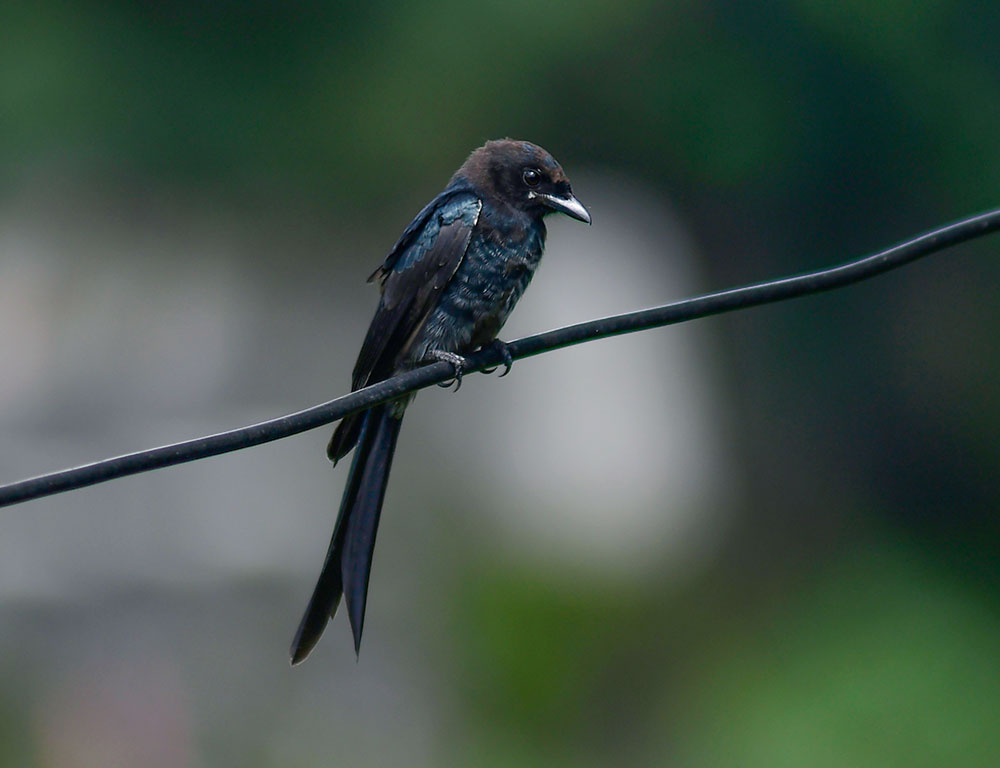
Drongos, known for their adaptability and unique behaviors, inhabit diverse habitats across Africa, Asia, and Australia. Their ability to thrive in various environments, from arid deserts to lush rainforests, showcases their remarkable adaptability.
Let’s delve deeper into their habitat preferences and behaviors:
Habitats
- Spangled Drongo: This species is found in Australia and Southeast Asia, particularly in humid forests along rivers. These habitats provide ample opportunities for foraging and nesting.
- Black Drongo: Black Drongos are primarily found in Asia, where they prefer open agricultural areas. Their habitat choice allows them access to abundant insect prey in such environments.
- Fork-tailed Drongo: Fork-tailed Drongos inhabit Africa, favoring dry savannas and woodlands. These habitats offer suitable perching spots for hunting insects and maintaining territorial boundaries.
Behavior
- Mimicry: Drongos are notorious mimics and use mimicry as a survival strategy. They mimic the alarm calls of other birds to create panic among potential prey or competitors, allowing them to steal food or escape from danger.
- Feeding: Drongos spend much of their time flying around hunting insects on the wing. They are skilled aerial hunters, swooping to catch prey or perching high up to scan for potential prey or predators.
- Territorial Defense: Despite being solitary creatures, drongos are territorial and defend their territory against intruders, even those much more significant than themselves.
Migration
Many drongo species are migratory birds, undertaking long-distance journeys during certain seasons. Migration allows them to follow seasonal changes in food availability and breeding opportunities, highlighting their adaptability to changing environmental conditions.
Diet of Drongos
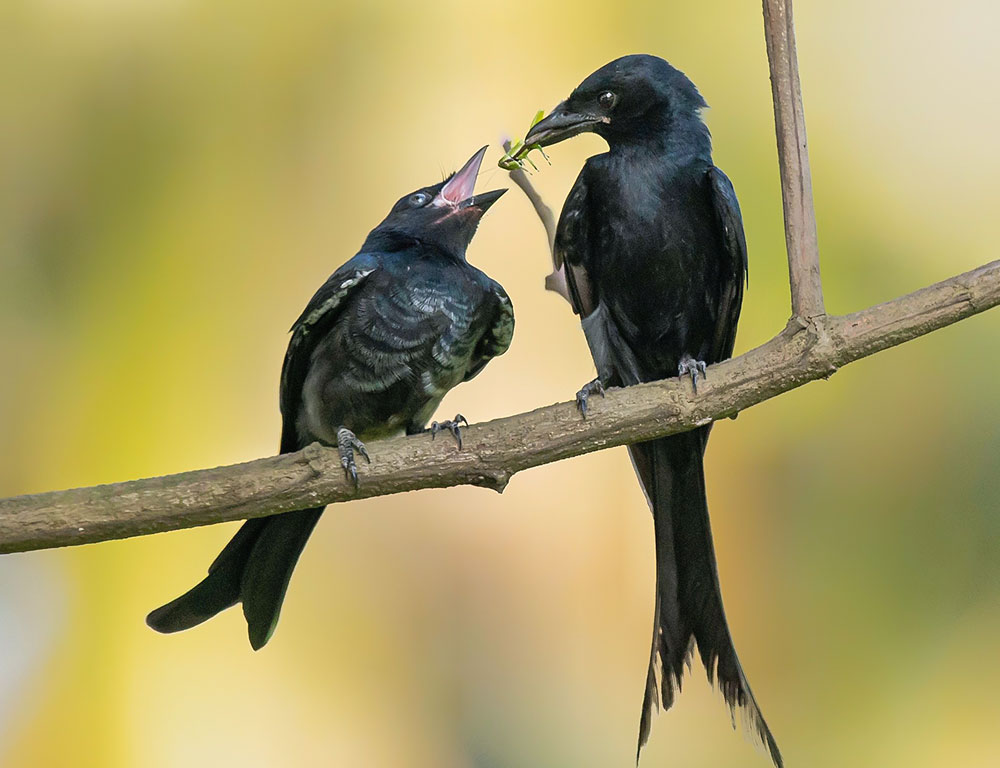
The diet of drongos, a fascinating bird species found primarily in Africa, Asia, and Australia, is quite diverse. These birds are opportunistic feeders, meaning they exploit various food sources depending on availability.
Here’s a summary of their diet:
Insects
Drongos primarily feed on insects. They are skilled aerial hunters, swooping down from their perches to catch insects such as crickets, beetles, spiders, and other small invertebrates.
Small Vertebrates
In addition to insects, drongos also consume small vertebrates. This may include small lizards, frogs, rodents, birds, or their eggs.
Fruits & Seeds
While insects and small vertebrates form the bulk of their diet, drongos also consume fruits and seeds occasionally. This makes them omnivores, as they incorporate plant matter into their diet alongside meat.
Stolen Food from Other Birds
Drongos are known for their clever trickery. They have learned to mimic the calls of other bird species, often using false alarm calls to deceive other birds into abandoning their food.
Once the coast is clear, drongos swoop in to steal the abandoned meal. This behavior showcases their opportunistic feeding strategies and intelligence.
Conservation Efforts for Drongos
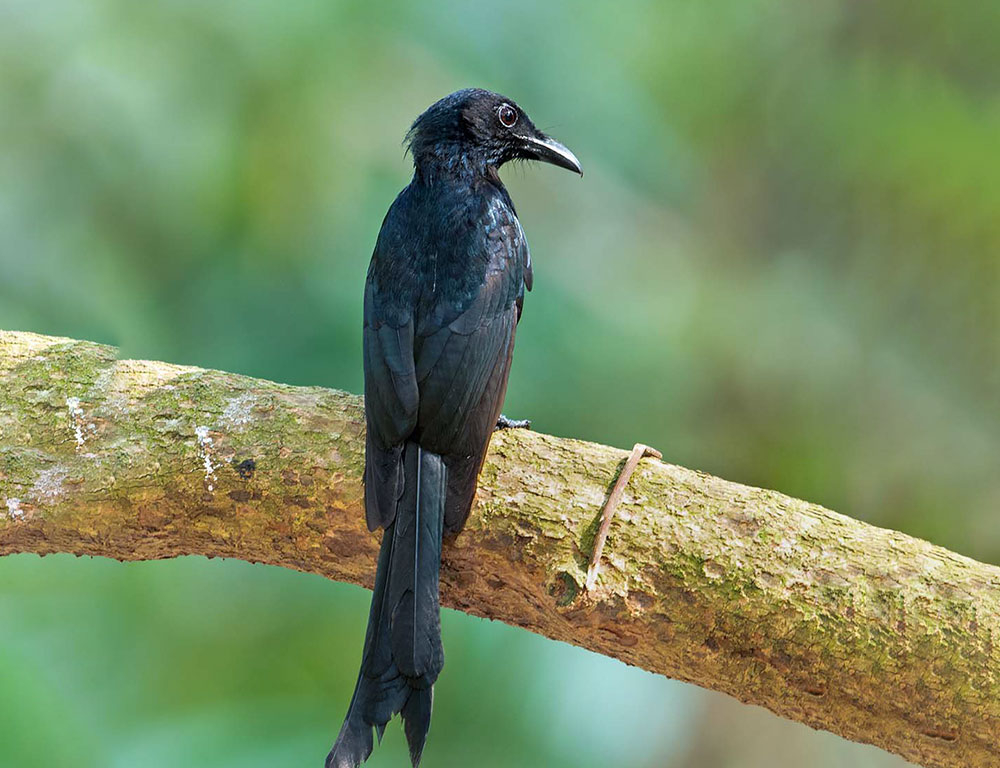
Conservation efforts for drongos, while not urgent due to their current non-endangered status, are still essential to ensure the long-term survival and well-being of these fascinating birds.
Here are some key initiatives being undertaken to protect drongos:
Habitat Preservation
Protecting the diverse habitats where drongos thrive is essential for their survival. Non-profit organizations worldwide are actively involved in initiatives such as land purchases, policy advocacy, and community education programs to safeguard drongo habitats.
Preserving forests, woodlands, grasslands, and even urban areas where drongos are found helps maintain their natural ecosystems.
Research
Understanding drongos’ behavior, diet, habitat requirements, and other aspects through scientific research is crucial for developing effective conservation strategies.
Scientists study various aspects of drongo biology to gather essential information that informs conservation efforts, enabling targeted and informed actions to protect these birds.
Breeding Programs
Some zoological institutions have implemented breeding programs for drongos under controlled conditions. These programs aim to increase drongo populations by breeding individuals in captivity and then releasing them back into the wild.
Breeding programs can help boost drongo numbers and enhance genetic diversity, contributing to their overall conservation.
Public Awareness
Raising public awareness about drongos and the importance of their conservation is vital for garnering support and fostering positive attitudes toward wildlife protection.
Education and outreach efforts inform people about the ecological role of drongos, their unique characteristics, and the threats they face.
By increasing public understanding and appreciation of drongos, individuals are more likely to engage in conservation actions and advocate for their protection.
Conclusion
Reflecting on our journey through the intriguing world of drongos, it’s clear that these birds are truly exceptional.
They’re striking with their glossy black feathers, distinctive forked tails, and intelligence and adaptability that sets them apart from many other bird species.
Drongos have shown us how survival in the wild can push boundaries. From their impressive mimicking skills to their strategic use of false alarm calls, these birds demonstrate an ingenious blend of cunning and resourcefulness. It’s fascinating to realize how much we’ve yet to learn about them.
Here are some key highlights from our deep dive into the life of drongos:
- Drongos are known for their uncanny ability to mimic the calls of different bird species.
- They use these mimicked calls primarily as a deceptive tool to steal food or deter predators.
- There’s evidence that suggests drongos even understand when specific calls will be most effective, displaying a degree of tactical thinking usually associated with higher mammals.
As we wrap up our exploration of drongos, let’s appreciate not just what we have discovered but also marvel at the intricate complexities still waiting in the wings.
The world around us is teeming with unexplored wonders – let’s keep our curiosity alive and continue seeking out knowledge wherever we can.